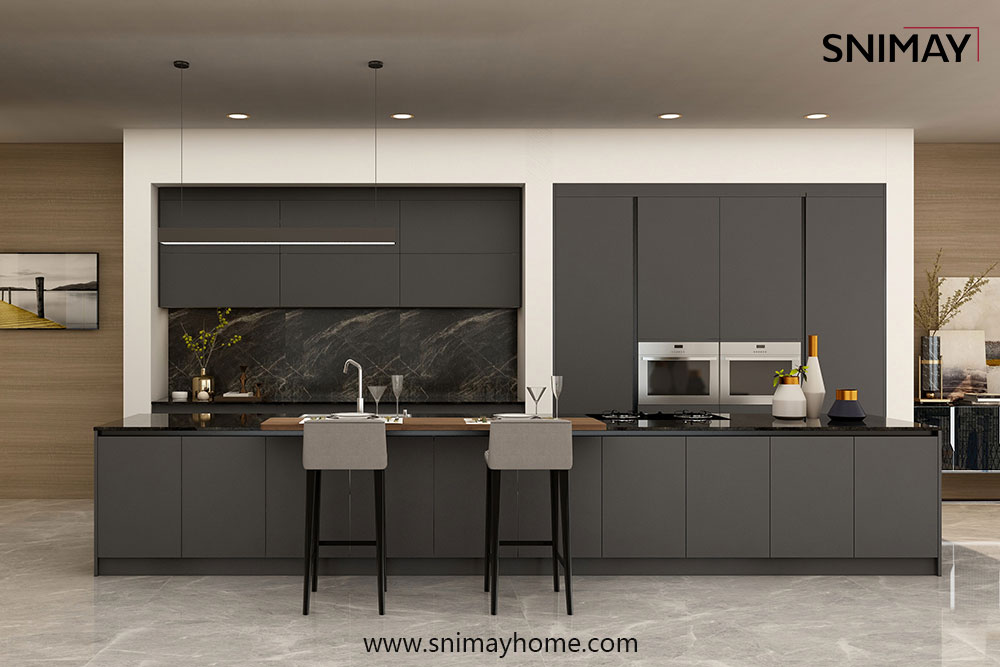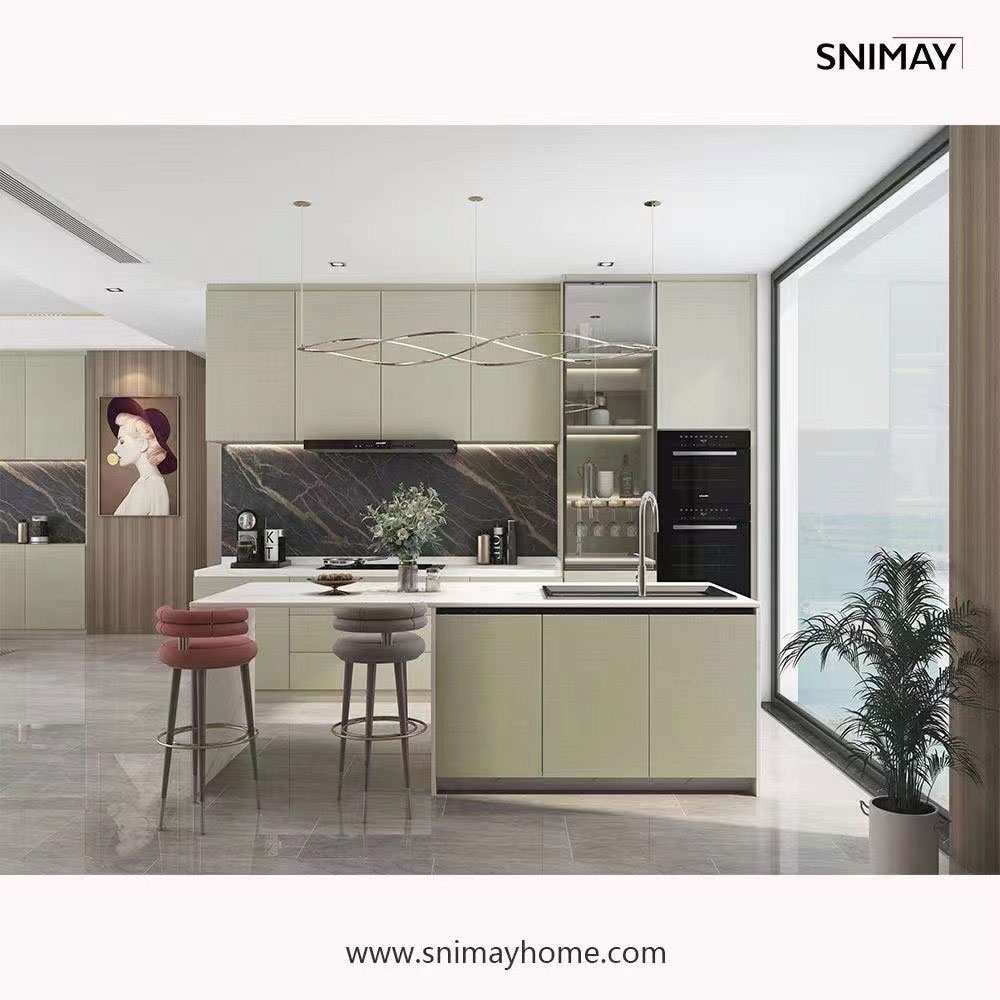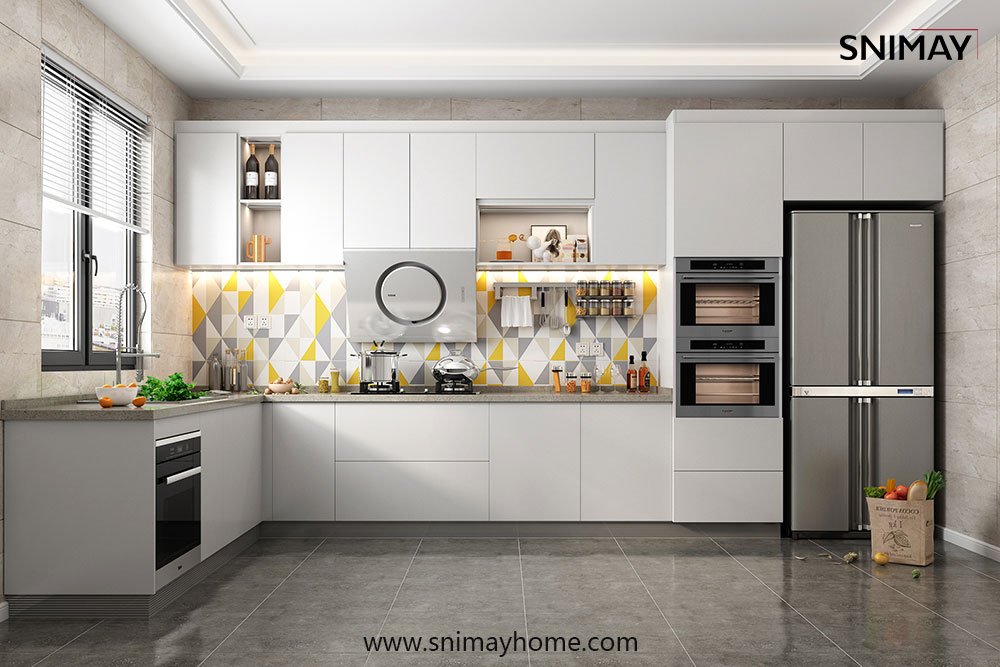
Cabinetry options
Melamine:
Commonly used for door and drawer fronts, melamine is made from resin-impregnated decorative paper bonded onto Medium Density Particleboard or Medium Density Fibreboard (MDF). Also known as laminate, it's available in a wide variety of colours, textures and wood grains.
Pro: Melamine is known for its scratch and moisture resistance, durability and quality finish on a budget. It’s also easy to clean.
Care: Wipe with warm, soapy water on a soft damp cloth, and follow with a streak-free cleaner on a soft cloth. Apply cleaning products directly onto the cloth, rather than the cabinet surface. Never use abrasive cleaning products.

High-gloss board/vinyl-wrap cabinetry:
A thin vinyl sheet is vacuum-sealed onto MDF.
Pro: Sophisticated, modern, glossy, more affordable than two-pack and highly durable, and withstands everyday wear and tear.
Care: Wipe with warm, soapy water on a soft damp cloth or sponge, and allow to air dry. Avoid using chemical cleaners, as these may damage the vinyl.
Two-pack polyurethane:
A technique and paint solution applied to cabinetry. Several different surface finishes are available, for example, high gloss, semi gloss, satin or matt.
Pro: Two-pack allows any custom colour to be selected.
Con: May be vulnerable to chipping.
Care: A clean microfibre cloth to gently wipe over the surface. For a more thorough clean, use warm soapy water and a microfibre cloth. Never use abrasive or solvent-based cleaners.
Timber:
In a classic, country-style kitchen, chances are it will feature timber cabinetry, boasting popular timber types such as Tasmanian or American oak.
Tip: Solid timber cabinetry is generally expensive so to keep costs down, use timber in just a couple of features, for example, benchtops or shelving.
Care: Mix a 50/50 solution of vinegar and warm water and pour it into a spray bottle. Spray onto cabinets, let sit for a minute or two and then wipe clean with a soft cloth.

Timber veneer:
Thin slices of timber are applied to boards and sealed with clear two-pack.
Pro: Timber veneer allows for the beauty and warmth of timber without the high cost.
Con: Ask your kitchen designer about the edging, which can get damaged. However, high-impact resistant ABS edging doesn't chip or peel.
Care: All spillages should be cleaned with a damp cloth as soon as possible, as moisture may damage the coating.
Tip: Timber veneer can be used to really encapsulate the much-loved Mid-Century Modern aesthetic.

The finish makes the difference
There are still more decisions to make, and these centre around the type of finish.
A semi-gloss finish provides some light-reflective qualities, durability and easy cleaning.
If looking to make a space appear larger and lighter, high-gloss cabinetry is a top choice as it reflects light. With its shiny finish, it is a staple of the contemporary-style kitchen.
Matte-finish cabinetry doesn't reflect light, looks more flat and can give a more consistent-looking and muted colour. We especially love matt finishes in a traditional or country-style kitchen.
When it comes to colours, a simple cabinetry colour palette of blacks, greys and whites will work well in a contemporary design. Light tones such as classic white has the potential to make a smaller kitchen feel larger, while darker shades add a sense of drama.

Door styles
The cabinetry door style is a highly visible element of your kitchen's design, and the style needs to marry with the overall aesthetic of not only your kitchen, but your entire home.
Simple and stylish, flat-panel doors are the ideal choice for a modern or contemporary kitchen.
Shaker-style doors are a simple and timeless design that suits most décor, and is considered a cabinetry classic.
One of the most expensive door styles, inset kitchen cabinet doors are a classic look. It's set inside the cabinet frame and requires exposed hinges.
 Call us on:
Call us on:  Email Us:
Email Us:  No.88 Fulian Rd , Shilou Town ,
Panyu District , Guangzhou ,
Guangdong , China
No.88 Fulian Rd , Shilou Town ,
Panyu District , Guangzhou ,
Guangdong , China